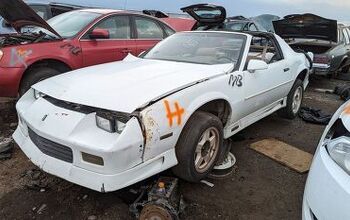Junkyard Find: 1992 Mercury Capri

Imagine it’s 1992 and you’re shopping for a sporty convertible: Do you get an Australian-built front-wheel-drive Mazda based on the 323 … or do you get a Miata?
Exactly.
As a result, the 1991-1994 Mercury Capri wasn’t a big seller in the United States, but I still see about as many of them in wrecking yards as I do Ford Capris (sold by Lincoln-Mercury dealers in the USA but not badged as Mercurys) and Mustang-sibling Fox Capris these days.
Under the hood, pretty much the same engine as the Miata, but flipped sideways. From what we’ve seen in the 24 Hours of LeMons, a well-driven Capri will get around a race track just about as quickly as its very distant Miata cousin (but a Miata with an ordinary driver will run away from a Capri with an ordinary driver).
It took a while for 1980s-style graphics to disappear from the flanks of cars.
Made in Australia!
Overseas, they can’t wait to get their hands on one. Can you?
Imagine being a Lincoln-Mercury salesperson during a brutal recession and having to sit through about 19 hours of these training videos. Third prize, you’re fired!

Murilee Martin is the pen name of Phil Greden, a writer who has lived in Minnesota, California, Georgia and (now) Colorado. He has toiled at copywriting, technical writing, junkmail writing, fiction writing and now automotive writing. He has owned many terrible vehicles and some good ones. He spends a great deal of time in self-service junkyards. These days, he writes for publications including Autoweek, Autoblog, Hagerty, The Truth About Cars and Capital One.
More by Murilee Martin
Latest Car Reviews
Read moreLatest Product Reviews
Read moreRecent Comments
- Jalop1991 In a manner similar to PHEV being the correct answer, I declare RPVs to be the correct answer here.We're doing it with certain aircraft; why not with cars on the ground, using hardware and tools like Telsa's "FSD" or GM's "SuperCruise" as the base?Take the local Uber driver out of the car, and put him in a professional centralized environment from where he drives me around. The system and the individual car can have awareness as well as gates, but he's responsible for the driving.Put the tech into my car, and let me buy it as needed. I need someone else to drive me home; hit the button and voila, I've hired a driver for the moment. I don't want to drive 11 hours to my vacation spot; hire the remote pilot for that. When I get there, I have my car and he's still at his normal location, piloting cars for other people.The system would allow for driver rest period, like what's required for truckers, so I might end up with multiple people driving me to the coast. I don't care. And they don't have to be physically with me, therefore they can be way cheaper.Charge taxi-type per-mile rates. For long drives, offer per-trip rates. Offer subscriptions, including miles/hours. Whatever.(And for grins, dress the remote pilots all as Johnnie.)Start this out with big rigs. Take the trucker away from the long haul driving, and let him be there for emergencies and the short haul parts of the trip.And in a manner similar to PHEVs being discredited, I fully expect to be razzed for this brilliant idea (not unlike how Alan Kay wasn't recognized until many many years later for his Dynabook vision).
- B-BodyBuick84 Not afraid of AV's as I highly doubt they will ever be %100 viable for our roads. Stop-and-go downtown city or rush hour highway traffic? I can see that, but otherwise there's simply too many variables. Bad weather conditions, faded road lines or markings, reflective surfaces with glare, etc. There's also the issue of cultural norms. About a decade ago there was actually an online test called 'The Morality Machine' one could do online where you were in control of an AV and choose what action to take when a crash was inevitable. I think something like 2.5 million people across the world participated? For example, do you hit and most likely kill the elderly couple strolling across the crosswalk or crash the vehicle into a cement barrier and almost certainly cause the death of the vehicle occupants? What if it's a parent and child? In N. America 98% of people choose to hit the elderly couple and save themselves while in Asia, the exact opposite happened where 98% choose to hit the parent and child. Why? Cultural differences. Asia puts a lot of emphasis on respecting their elderly while N. America has a culture of 'save/ protect the children'. Are these AV's going to respect that culture? Is a VW Jetta or Buick Envision AV going to have different programming depending on whether it's sold in Canada or Taiwan? how's that going to effect legislation and legal battles when a crash inevitibly does happen? These are the true barriers to mass AV adoption, and in the 10 years since that test came out, there has been zero answers or progress on this matter. So no, I'm not afraid of AV's simply because with the exception of a few specific situations, most avenues are going to prove to be a dead-end for automakers.
- Mike Bradley Autonomous cars were developed in Silicon Valley. For new products there, the standard business plan is to put a barely-functioning product on the market right away and wait for the early-adopter customers to find the flaws. That's exactly what's happened. Detroit's plan is pretty much the opposite, but Detroit isn't developing this product. That's why dealers, for instance, haven't been trained in the cars.
- Dartman https://apnews.com/article/artificial-intelligence-fighter-jets-air-force-6a1100c96a73ca9b7f41cbd6a2753fdaAutonomous/Ai is here now. The question is implementation and acceptance.
- FreedMike If Dodge were smart - and I don't think they are - they'd spend their money refreshing and reworking the Durango (which I think is entering model year 3,221), versus going down the same "stuff 'em full of motor and give 'em cool new paint options" path. That's the approach they used with the Charger and Challenger, and both those models are dead. The Durango is still a strong product in a strong market; why not keep it fresher?



















































Comments
Join the conversation
I had one of these for about 7 years/100k miles. Despite only twice-a-year Jiffy Lube maintenance, nothing went wrong except a snapped window cable which I replaced for $10 from Orchard Supply. It was much roomier than a Miata; the vestigial back seat was usable at a pinch and allowed the fronts to almost fully recline for camping. The roof packed completely into the body shell for a clean look, and when raised allowed a pass through for things like skis (yes, I took it both skiing and camping).
An older empty nest couple had one of these in my parents neighborhood growing up, teal green with a white top, I always liked it, and thought it was neat. I remember them replacing it with a 98 BMW Z in dark green. I don't know why but I always noticed these when I saw them. I think we will someday look back fondly at a time where a sub compact convertible was smaller than a new Mini Cooper.